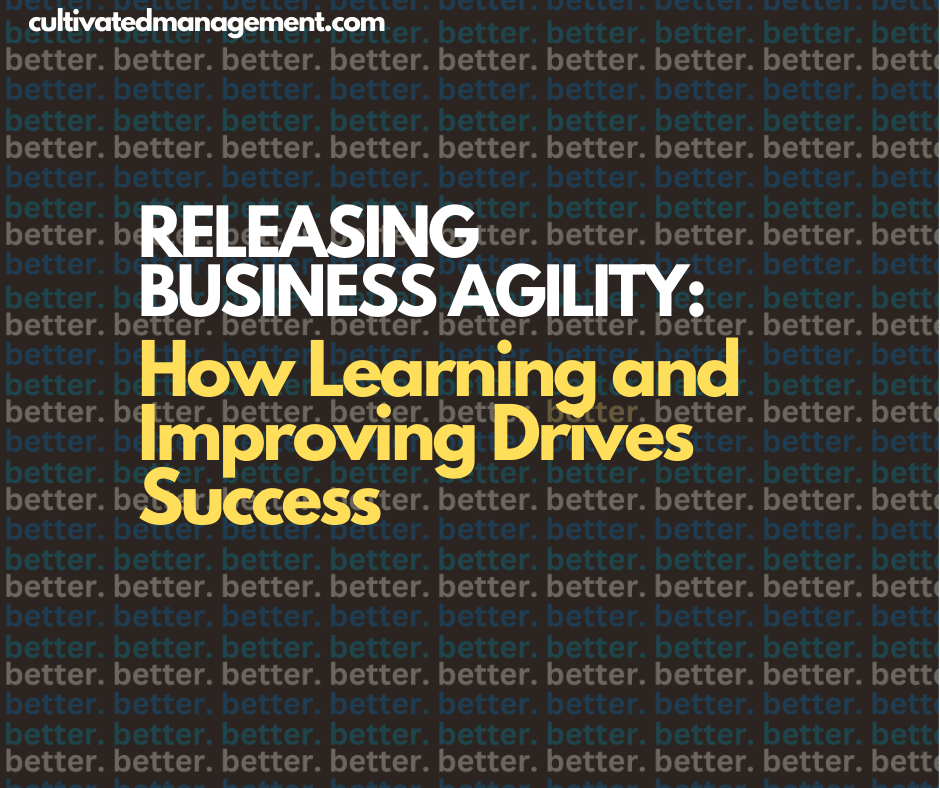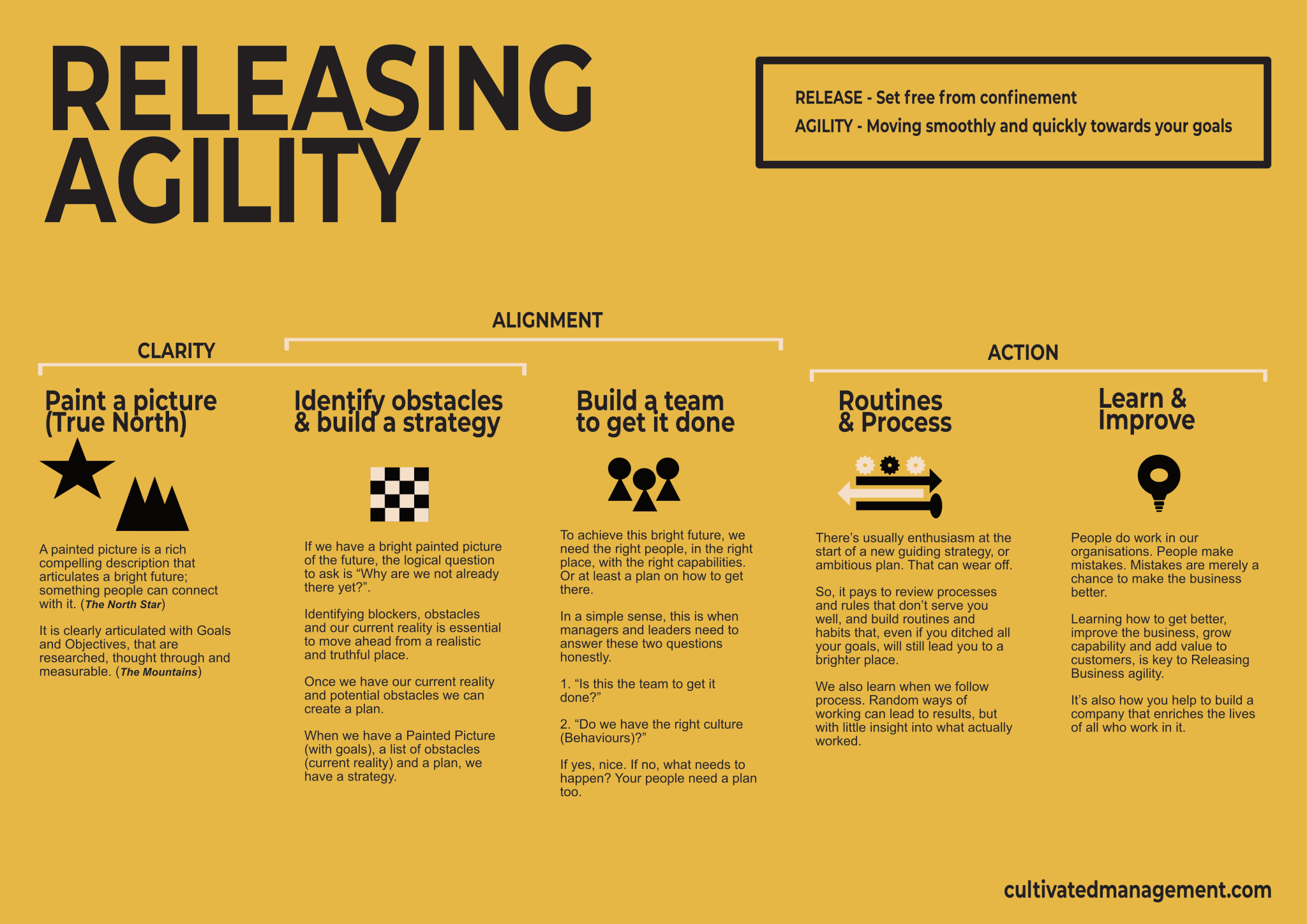
Business agility isn’t just a buzzword — it’s a mindset. It’s about moving smoothly and quickly toward your goals while creating a workplace that enriches the lives of the people within it.
One of the most critical steps in achieving this is Step 5 of the Releasing Agility model: Learning and Improving.

This step is the engine that drives continuous improvement, ensuring that organisations don’t just execute tasks but get better over time. It’s where reflection, capability building, and practical experimentation come together to create lasting impact.
Here's a podcast for your ears, or read on for more.
Learning from Mistakes
At the heart of Step 5 is the recognition that mistakes are not failures — they are opportunities to learn and improve. Many organisations focus on blame when something goes wrong. Leaders hunt for who is “at fault,” rather than asking, “What can we learn from this?”
A more productive approach is to draw a circle around yourself first. Ask: “What role did I play in this problem, and how can I fix it?” Leaders and managers often inadvertently contribute to issues through unclear instructions, poorly designed processes, or unrealistic expectations. By acknowledging your part in creating problems, you can take ownership of solutions.
For example, if a product ships with quality issues, don’t start by blaming the team. Instead, investigate the process: Were routines clearly defined? Did the team have the right training and resources? What could have been anticipated or communicated differently? Root-cause analysis isn’t about punishment; it’s about improving systems, processes, and performance.
Building Capability
Capability is often used as a catch-all term, but it’s crucial to break it down. In a business context, capability refers to:
- People who are already capable of doing a specific task.
- People who have the potential to become capable.
- Those who may be better suited to different roles.
Leaders need to know their team well. Understanding individual strengths, weaknesses, and career aspirations allows you to build effective learning pathways and maximise performance.
Pairing people who are already capable with those developing their skills is one of the most effective ways to increase team capability. Mentoring, coaching, and on-the-job training accelerate learning and embed new skills in real work contexts.
👉 Check out this post on Capable Vs Capability
Information vs Task Acquisition
Learning and improvement can be split into two approaches: information acquisition and task acquisition.
- Information acquisition is about consuming knowledge—reading, attending training sessions, or researching best practices. This is valuable, but knowledge alone doesn’t create capability.
- Task acquisition is learning by doing. It’s active, hands-on, and experiential. Think of learning a musical instrument: You can read every book about piano, but you won’t truly learn to play until you practice.
The most effective learning strategies combine both. Leaders should provide access to information while also creating opportunities for real-world application. Pairing task acquisition with guidance from experienced colleagues creates an environment where teams can develop practical skills while improving business outcomes.
👉 Check out this post going into more depth on these two crucial learning approaches
Continuous Improvement as a Mindset
Learning and improving isn’t a separate step — it should be embedded across every activity in the organisation. From the moment a team begins a new project, leaders should be observing, reflecting, and iterating. This includes:
- Reviewing what worked and what didn’t.
- Identifying bottlenecks and process inefficiencies.
- Coaching individuals to improve performance.
- Adjusting routines, tools, and systems to remove friction.
By consistently integrating reflection and improvement into daily work, organisations create a culture of learning rather than punishment, blame, or stagnation.
Why Step 5 Matters
Step 5 ensures that organisations don’t just move fast — they move with intent and knowledge. By focusing on learning and improving, businesses can:
- Reduce recurring problems by addressing root causes rather than symptoms.
- Build team capability and confidence.
- Foster a culture where mistakes are treated as learning opportunities, not reasons for blame.
- Encourage experimentation and innovation without fear.
- Align processes and routines with business goals while continuously optimizing them.
Without this step, organisations risk repeating the same mistakes, demotivating staff, and wasting time and resources on avoidable issues.
Practical Strategies for Learning and Improving
Here are some practical ways to embed Step 5 into your organisation:
- Reflect regularly: Schedule retrospectives or reflection sessions after projects or key milestones. Ask what went well, what didn’t, and how the process could improve.
- Pair learning with doing: Encourage on-the-job training. Pair capable employees with those developing skills to foster mentorship and practical learning.
- Separate capability from potential: Identify who can perform tasks today, who can grow into them, and who may be better suited elsewhere. Tailor coaching accordingly.
- Analyse processes: Use root-cause analysis to identify gaps in routines, tools, or workflows that contribute to mistakes.
- Encourage experimentation: Promote a safe environment for teams to test new approaches. Celebrate learning outcomes, not just success.
- Measure outcomes: Track improvements over time. Metrics like cycle time, throughput, or failure demand can highlight where processes are improving and where further intervention is needed.
Learning is Continuous
One of the key insights of Step 5 is that learning never stops. From the first steps of painting a future vision to designing goals, tackling obstacles, and building routines, leaders are continuously learning about themselves, their teams, and the organisation.
By the time you reach Step 5 formally, you should already have developed a mindset of reflection, learning, and adaptation. Embedding this step ensures that growth and improvement are intentional, systematic, and sustainable.
👉 See this post on creating a learning culture
Creating an Enriching Work Environment
The ultimate goal of learning and improving is to enhance not only business performance but also the quality of the workplace experience. Organizations that embrace this approach:
- Enable employees to grow and develop their skills.
- Build resilient teams capable of adapting to change.
- Encourage collaboration and problem-solving across levels.
- Create a culture where work is fulfilling and mistakes are part of growth.
When organisations combine business results with enriching employee experiences, they achieve agility that is both sustainable and human-centered.
Conclusion
Step 5 of the Releasing Business Agility model — Learning and Improving — is about more than fixing mistakes. It’s about building capability, fostering reflection, and creating a culture of continuous growth. By pairing information acquisition with task acquisition, analysing root causes, and embedding learning across every process, organisations can move faster, smarter, and more effectively toward their goals.
Leaders who embrace this mindset will see not only improved performance but also a workplace that nurtures potential, develops skills, and enriches the lives of everyone involved.
Business success and employee satisfaction are not mutually exclusive — they go hand in hand when learning and improving is at the core of your strategy.
